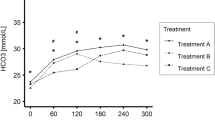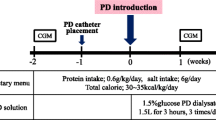Abstract.
Glucose has been omitted from hemodialysates in the recent past. Currently, there is a tendency to include glucose in dialysates at physiological concentrations between 100 and 200 mg/dl (5.56–11.12 mmol/l). In adult patients, this induces, over the dialysis session, a significant uptake of glucose, with some benefits, i.e., avoidance of caloric loss, but also with some metabolic risks, i.e. decreased dialytic potassium removal secondary to an insulin-dependent intracellular potassium shift. We have performed a crossover study in five stable children (mean age 11.7 years) with normal fasting glucose on chronic bicarbonate hemodialysis. The dialysis prescription of 3-h sessions was changed only in terms of the glucose dialysate concentration, being either glucose free or containing 9.17 mmol/l (165 mg/dl) glucose; dialysates were potassium free. Twenty sessions were analyzed for each group by whole dialysate collection (glucose, potassium, phosphate) and serum concentration analysis during and post dialysis (glucose, potassium, phosphate, insulin). Glucose-free dialysis was associated with a patient net glucose loss of 113±12 mmol/session (nearly 20 g). Conversely, with the glucose-charged dialysate a small uptake of glucose was noted [13.8±2.1 mmol/session (nearly 2 g)]. At the end of the session, serum glucose was lower with the glucose-free dialysate (4.64±0.52 mmol/l) than the glucose-charged dialysate (6.11±0.92 mmol/l). Conversely, serum insulin was higher with the glucose-charged dialysate (38±17 mU/l) than the glucose-free dialysate (19±9 mU/l). There were no significant differences either for dialytic removal of potassium (70 vs. 73 mmol/session) or phosphate (20 vs. 22 mmol/session), with and without glucose dialysates. Our study, contrary to previously published data in adults, demonstrated that in children the use of a physiological concentration of glucose in the dialysate (165 mg/dl) avoids dialytic glucose loss without a significant decrease in dialytic potassium removal.
Similar content being viewed by others
Author information
Authors and Affiliations
Additional information
Received January 29, 1997; received in revised form July 17, 1997; accepted July 22, 1997
Rights and permissions
About this article
Cite this article
Fischbach, M., Terzic, J., Cohen, C. et al. Glucose-charged dialysate for children on hemodialysis: acute dialytic changes. Pediatr Nephrol 12, 60–62 (1998). https://doi.org/10.1007/s004670050404
Published:
Issue Date:
DOI: https://doi.org/10.1007/s004670050404




